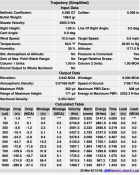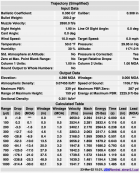The issues associated with 168 gr .30 cal bullets stem from the design of the 168 SMK bullet. It has a relatively steep boattail angle (13 degrees) that induces dynamic instability at ranges of around 800+ yds or so, depending somewhat on velocity and twist rate; i.e. higher velocity and a faster-than-necessary twist rate may improve performance a bit with the 168 SMKs. This is a totally different situation than typical gyroscopic instability as caused by using an insufficient twist rate barrel, and it is caused solely by the bullet design. Any other 168 gr bullet design that doesn't have the 13 degree boattail angle will work just fine out to 1000 yd. People have been shooting lighter/lower BC 155 gr weight class .30 cal bullets out to 1000 yd for a long time, and they don't suddenly fall out of the sky after 800 yd. Sierra's new 169 gr bullet was designed in part to remedy the dynamic instability issue of the original 168 SMK.
As an example, I have used the Berger 168 Hybrid bullet for a number of years. It is an excellent design that does not suffer from an excessively steep boattail angle or dynamic instability. In my hands, they tune in at around 2900-ish fps from a 30" barrel using H4895. Attached below is an external ballistics prediction from JBM Ballistics using my typical velocity/atmospheric data for pointed 168 Hybrids. As you can see, they are predicted to remain supersonic out to at least 1000 yd, and I have never observed any abnormal behavior when shooting that load at that distance. As with any lighter bullet, the main downside is that the BC will generally be lower than heavier weight classes of bullets, even though you get a little bit of resistance to wind deflection back due the higher velocity at which you launch the lighter bullets. As you can see from the attached ballistic prediction for the 200.20X bullet, a typical F-TR load with pointed 200.20X bullets and Varget (2650 fps) will shoot inside the 168 Hybrid load by slightly under one half MOA at 600 yd, but the predicted windage differential goes up to one full MOA at 1000 yd. That is largely because the heavier, higher BC 200.20X bullet retains velocity much better than the lighter, lower BC 168 Hybrid. As you can see, the 200.20X bullet is predicted to arrive at 1000 yd with approximately 50 fps greater velocity than the 168 Hybrid, even though its initial (muzzle) velocity was slower by ~255 fps.
There is nothing wrong with using lighter/lower BC .30 cal bullets for shooting at 1000 yd, especially as not everyone's rifle is throated long for loading much heavier/longer bullets. The most important thing to remember is that the instability associated with 168 SMK past about 800 yd is a design issue, and it is not associated with other 168 gr bullets that do not possess the same steep 13 degree boattail angle. Using a lighter/lower BC bullet simply means that your wind reading skills have to be that much better. Obviously, that observation is more critical for competitive shooting, where points matter. That is why you won't see many F-TR shooters using 155 or 168 gr .30 cal bullets these days. It would simply mean giving up too much wind deflection to shooters using 200+ gr bullets, and the final scores would likely reflect that windage differential. However, there is no reason bullets within the lighter 155-168 gr weight classes can't be used for shooting at 1000 yd, especially if that is the bullet length for which the rifle is appropriately throated.












